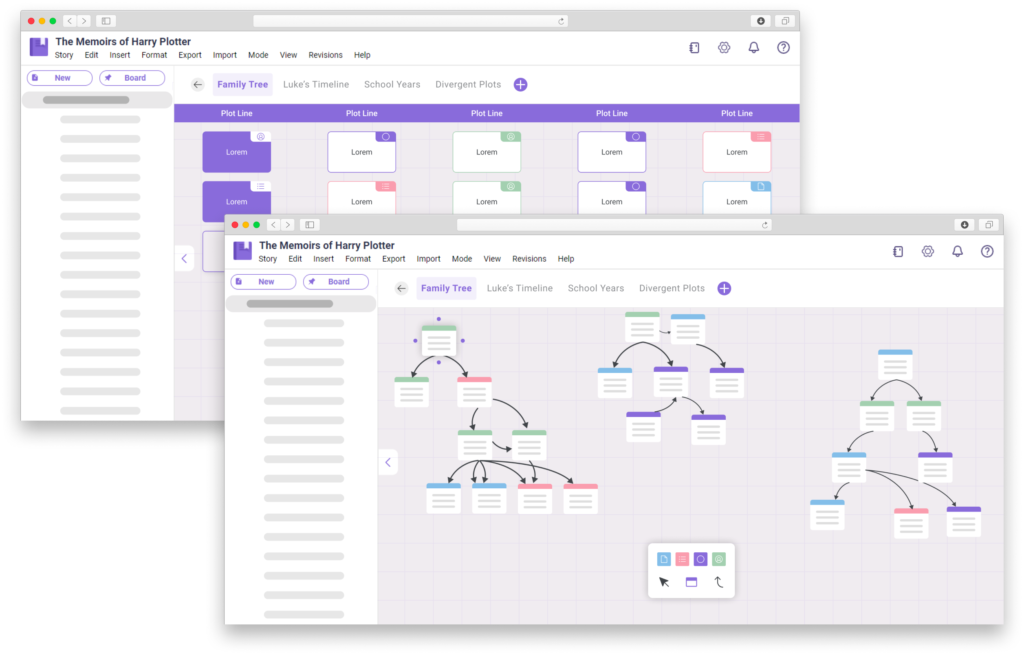As many writers move into the online space, software tools like Scrivener seem to be less efficient and web-based editors are the best alternative to your basic word processors in writing your novel. This is why LivingWriter has been built to be an author’s best writing companion wherever they might be in the world.
However, how exactly does LivingWriter compare to alternatives in the market? Let’s have a feature showdown between LivingWriter and Dabble, a similar product in the online writing space.
User Interface
Right off the bat, Dabble obviously follows a similar design language with Scrivener. The striking similarity can be comforting for Scrivener users, which is actually their target audience, given their claim of being “Like Scrivener. Minus the Learning Curve.” It can be the aesthetic of the platform itself, but Scrivener’s dated design (and consequently Dabble’s) is definitely a hit-or-miss for many.

On the other hand, LivingWriter embraces a more modern design, with a subjectively more inspiring purple palette across the platform. This makes the entire place seem more full of life, unlike Dabble’s insistence of a “traditional book” gray-dominant look. Where Dabble misses an entire menu bar, LivingWriter places one, because you will need to have access to all the features it offers you.
While Dabble prides themselves on a “simple” design, the entire space instead looks bland and empty. LivingWriter also employs a simplistic design, but in a way where the space looks “breathable” yet not sparse of features.
Although there is no clear winner for this category, we can back up that LivingWriter is a brighter space that easily slots itself as a modern writing platform, from looks to features.
Templates
LivingWriter offers a plethora of templates that cater to both fiction and non-fiction pieces. These templates are all based on the writing styles of popular writers and prominent writing frameworks used by many authors worldwide, so you can easily have a head start when you are in dire need of a push in the right direction.
Each template is also a guide: they teach new writers how to work on the framework to maximize their efficiency while writing. These templates are also ever-expanding, as the team behind LivingWriter strives to scour the land for more writing frameworks to help new writers get their feet wet into writing.
Unfortunately, Dabble does not offer any templates on their platform, which is a bummer. Obviously, then, LivingWriter is the clear winner here.
Check out the writing templates that LivingWriter offers!
Plotting Tools
The outlining work of a novel can be overwhelming, so both platforms offer convenient plotting tools to help out their writers.
Dabble offers a plot grid, allowing writers to plan out chapters together with their subplots within plot lines. The interface allows for conveniently dragging these index card-like boxes, where each plot point goes, into any plot line that you might want. Truth be told, this can be good fun while you’re plotting.
However, LivingWriter offers that and more. LivingWriter provides a Plot Board, where you can have a Standard Grid and a Freeform Grid. The Standard Grid is strikingly similar to Dabble’s plot grid, but the Freeform Grid is another thing entirely. The Freeform Grid allows you to create something like a mind map, connecting plot points using lines. This is a better visual experience than the Standard Grid, if it feels too bland for you.

Another thing is that LivingWriter’s Plot Board combines very well with its Outlines and Chapters, another plotting tool available in LivingWriter. Bearing a similarity to that of index cards in a board, Outlines and Chapters can be viewed on the Board, giving you an overview of your outline. Where the Plot Board offers a chronological view of your plot, the Outlines and Chapters go into deeper detail for each chapter and scene. Plus, you can easily import descriptions you’ve written in the Outlines and Chapters into any of the Grids, giving you the best of both worlds.
With LivingWriter’s more robust plotting tools, Dabble simply falls short in this category. LivingWriter takes the win for this one.
Story Notes
Aside from plotting tools, you’ll also want a single place to compile all your collections of notes and research you’ve done for your novel. Of course, both Dabble and LivingWriter have a notes feature.
Dabble’s Story Notes includes all notes, whether for characters or the world setting. You can store text notes in their Story Notes, sort them into folders, then go through them if you need a certain piece of information sometime later.
However, again LivingWriter improves upon what Dabble has and provides more. LivingWriter provides two avenues for storing notes: the Story Elements and the Research Board. The Story Elements contains notes for characters, settings, objects, and other entities in your story. Not just notes, too, but also images for your visual reference.
What makes the Story Elements great is that it integrates well while you’re writing your manuscript. When you mention an object anywhere in your manuscript, LivingWriter detects it and then shows your notes of that object in the sidebar, allowing you access to all your notes right away.
The Research Board is the place where you store your actual research notes. You can create a Research Section, where you can store article links, images, document files, and of course, notes. The Research Board is a multimedia storage place for all your research, no matter what format they are.
However, one of the best features of LivingWriter’s notes is an expanded global search feature, allowing you to search through Outlines and Chapters, Story Elements, and the Research Board. You don’t have to spend a lot of time sifting through your notes; just search it up and it will be in your hands before you know it.
Dabble’s Story Notes might be enough for some, but LivingWriter’s Story Elements and Research Board are more than enough to blow the competitor away.
Platform Availability
Both Dabble and LivingWriter are web-based, so any device with a decent Internet connection can easily open both and work wherever they want. As such, both also offer online backups. However, only LivingWriter offers a revision history, allowing you to view your manuscript at any previous point in time. Online collaboration is also available for both products.
However, while Dabble is purely web-based, LivingWriter also provides a standalone desktop app for Windows and Mac, with mobile versions available in iOS and Android. If you can’t bear using a browser, these apps are more than enough to get you working on your novel wherever you are, whatever device you have.
Again, the clear winner for this is LivingWriter: the multiple avenues of availability ensure that you can work at any place and device that you want.
Conclusion
Distraction-free mode, dark mode, and other commonalities between Dabble and LivingWriter are a given at this point. However, in this feature comparison, we can see that Dabble’s pride in simplicity breaks down when pitted against a product with a robust feature set like LivingWriter.
There might be beauty in Dabble’s simplicity, but when you’re being asked $20 a month for the full experience when you can have that and more at half the price with LivingWriter’s $9.99 per month, you’d be pressed to choose LivingWriter.



